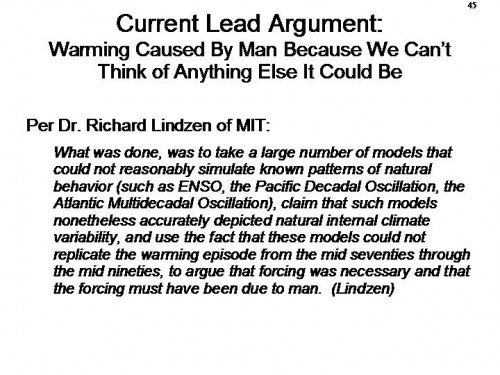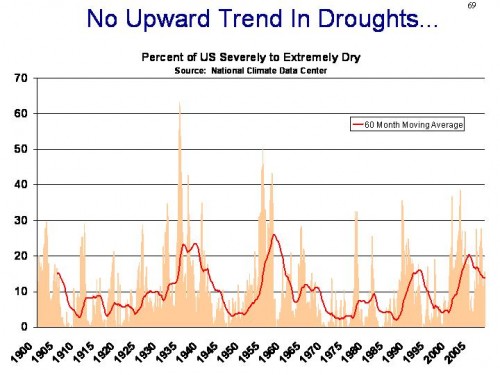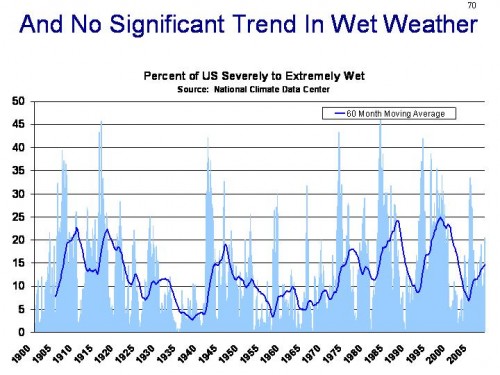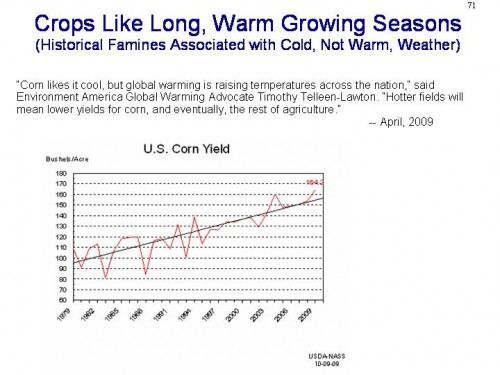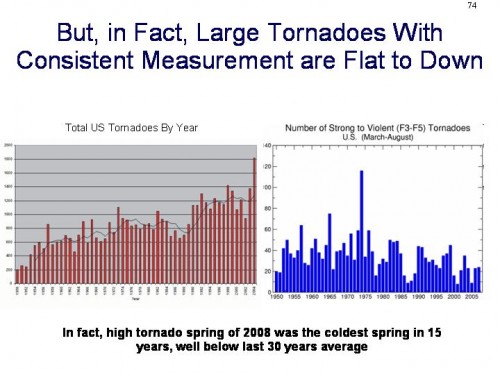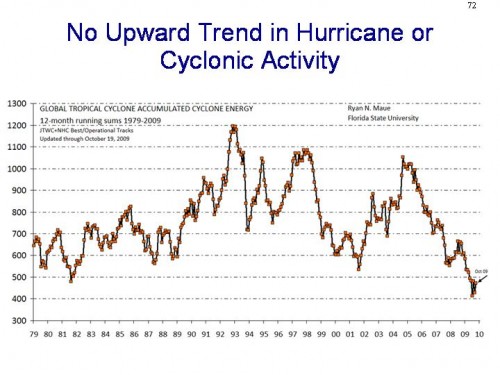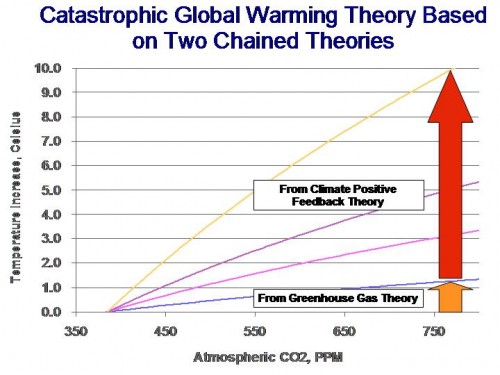I will be making a presentation on the science of the climate skeptic’s position on April 12 from 5-7PM at the University of Colorado – Colorado Springs (UCCS) in the UC 302 theater (campus map). I hope folks who are interested in the Denver / Colorado Springs area will attend.
Monthly Archives: March 2010
Valley Forward Remarks
Below the fold are my remarks to the Valley Forward lunch today — I only had five minutes, so I was fairly limited.
Is It Wrong to Apply a Simple Amplifier Gain Mental Model to Climate?
Today will actually be fun, because it involves criticism of some of my writing around what I find to be the most interesting issue in climate, that of feedback effects. I have said for a while that greenhouse gas theory is nearly irrelevant to the climate debate, because most scientists believe that the climate sensitivity to CO2 acting along without feedbacks is low enough (1.2C per doubling) to not really be catastrophic. So the question whether man-made warming will be catastrophic depends on the assumption of strong net positive feedbacks in the climate system. B Kalafut believes I have the wrong mental model for thinking about feedback in climate, and I want to review his post in depth.
Naming positive feedbacks is easy. In paleoclimate, consider the effect of albedo changes at the beginning of an ice age or the “lagging CO2” at the end. In the modern climate, consider water vapor as a greenhouse gas, or albedo changes as ice melts. In everyday experience, consider convection’s role in sustaining a fire. Consider the nucleation of raindrops or snowflakes or bubbles in a pot of boiling water. At the cellular level, consider the voltage-gated behavior of the sodium channels in a nerve axon or the “negative damping” of hair cells in the cochlea.
I am assuming he is refuting my statement that “it is hard to find systems dominated by strong net positive feedbacks that are stable over long periods of time.” I certainly never said individual positive feedbacks don’t exist, and even mentioned some related to climate, such as ice albedo and increases in water vapor in air. I am not sure we are getting anywhere here, but his next paragraph is more interesting.
On to the meat of Meyer’s argument: he seizes on one word (“feedback”) and runs madly, from metaphor to mental model. Metaphor: “like in an ideal amplifier”. Model: The climate experiences linear feedback as in an amplifier–see the math in his linked post or in the Lindzen slides from which he gets the idea. And then he makes the even worse leap, to claiming that climate models (GCMs) “use” something called “feedback fractions”. They do not–they take no such parameters as inputs but rather attempt to simulate the effects of the various feedback phenomena directly. This error alone renders Meyer’s take worthless–it’s as though he enquires about what sort of oats and hay one feeds a Ford Mustang. Feedback in climate are also nonlinear and time-dependent–consider why the water vapor feedback doesn’t continue until the oceans evaporate–so the ideal amplifier model cannot even be “forced” to apply.
First, I don’t remember ever claiming that climate models used a straight feedback-amplification method. And I am absolutely positive I never said GCM’s use feedback fractions. I would not expect them to. This is a total straw man. I am using a simple feedback amplification model as an abstraction to represent the net results of the models in a way layman might understand, and backing into an implied fraction f from published warming forecasts and comparing them to the 1.2C non-feedback number. Much in the same way that scientists use the concept of climate sensitivity to shortcut a lot of messy detail and non-linearity. I am, however, open to the possibility that mine is a poor mental model, so lets think about it.
Let’s start with an analogy. There are very complicated electronic circuits in my stereo amplifier. Nowadays, when people design those circuits, they have sophisticated modeling programs that can do a time-based simulation of voltage and current at every point in the circuit. For a simulated input, the program will predict the output, and show it over time, even if it is messy and non-linear. These models are in some ways like climate models, except that we understand electronic components better so our parametrization is more precise and reliable. All that being said, it does not change the fact that a simple feedback-gain model for sections of the complex amplifier circuitry is still a useful mental model for the process at some level of abstraction, as long as one understands the shortcomings that come from any such simplification.
The author is essentially challenging the use of Gain = 1/ (1-f) to represent the operation of the feedbacks here. So let’s think about if this is appropriate. Let’s begin with thinking about a single feedback, ice albedo. The theory is that there is some amount of warming from CO2, call it dT. This dT will cause more ice to melt than otherwise would have (or less ice to form in the winter). The ice normally reflects more heat and sunlight back into space than open ocean or bare ground, so when it is reduced, the Earth gets a small incremental heat flux that will result in an increase in temperatures. We will call this extra increase in temperature f*dT where f is most likely a positive number less than one. So now our total increase, call it dT’ is dT+f*dT. But this increase of f*dT will in turn cause some more ice to melt. By the same logic as above, this increase will be f*f*dT. And so on in an infinite series. The solution to this series for a constant value of f is dT’ = dT/(1-f) … thus the formula above.
So the underlying operation of the feedback is the same: Input –> output –> output modifies input. There are not somehow different flavors or types of feedback that operate in radically different ways but have the same name (as in his Mustang joke).
The author claims the climate models are building up the affects of the processes like ice albedo from its pieces, ie rather than abstracting in to the gain formula, the models are adding up all the individual pieces, on a grid, over time. I am sure that is true. The question is not whether they use the simplified feedback formula, but whether it is a useful abstraction. I see nothing from my description of the ice albedo process to say it is not.
What happens if there are time delays? Well, as long as f is less than 1, the system will reach steady state at some point and this formula should apply. What happens if the feedback is non-liner? Well, in most natural systems, it is almost certainly non-linear. In our ice albedo example, f is almost certainly different at different temperatures levels (for example, a change from -30C to -31C has a lot less effect on ice albedo than a change from 0C to 1C. The factor f is probably also dependent on the amount of ice remaining, since in the limit when all the ice is melted there should be no further effect. But I would argue that when we pull back and look at the forest instead of the trees, a critical skill for modelers who too often get buried in their minutia while losing the ability to reality-check their results, that the 1/(1-f) is still an interesting if imperfect abstraction for the results, particularly since we are looking at tenths of a degree, and its hard for me to believe that it is wildly non-linear over that kind of range. (By the way, it is not at all unusual for mainstream alarmist scientists to use this same feedback formula as a useful though imperfect abstraction, for example in Gerard H. Roe and Marcia B. Baker, “Why Is Climate Sensitivity So Unpredictable?”, Science 318 (2007): 629–632 Not free but summarized here.)
To determine if it is a useful abstraction, I would ask the author what conclusions I draw that fall apart. I really only made two points with the use of feedback anyway.
- I used the discussion to educate people that feedback is the main source of catastrophic warming, so that it should be the main focus of the scientific replication. We can argue all day about time delays and non-linearity, but if the IPCC says the warming from CO2 alone is going to be 1.2C per doubling and the warming with all feedbacks considered is going to be, say, 4.8C per doubling (the author says himself that the models all converge at constant CO2), then we can say feedback is amplifying the initial man-made input by 4, or alternatively, 75% of the warming is from feedback effects, so these are probably where we need to focus. I struggle to see how one can argue with this.
- I used the simple gain formula to say if feedback were quadrupling temperatures, this implies a feedback factor of 0.75, and that this number is pretty dang high for a long-term stable system. Yes, the feedback is non-linear, but I don’t think this is an unreasonable reality check on the models to see what sorts of average feedbacks are being produced by the parameters.
The author’s points on non-linearity and time delays are actually more relevant to the discussion in other presentations when I talked about whether the climate models that show high future sensitivities to CO2 are consistent with past history, particularly if warming in the surface temperature record is exaggerated by urban biases. But even forgetting about these, it is really hard to reconcile sensitivities of, say, four degrees per doubling with history, where we have had about 0.6C (assuming irrationally that its all man-made) of warming in about 42% of a doubling (the effect, I will add, is non-linear, so one should see more warming in the first half than the second half of a doubling). Let’s leave out aerosols for today (those are the great modeler’s miracle cure that allows every model, even those of widely varying CO2 sensitivities and feedback effects, all exactly back-cast to history). These time delays and non-linearities could help reconcile the two, though my understanding is that the time delay is thought to be on the order of 12 years, which would not reconcile things at all. I suppose one could assume non-linearity such that the feedback effects accelerate with time past some tipping point, but I will say I have yet to see any convincing physical study that points to this effect.
Well, the weather is lovely outside so I suppose I should get on with it:
Meyer draws heavily from a set of slides from a talk by Richard Lindzen before a noncritical audience. These slides are full of invective and conspiracy talk, and their scientific content is lousy. Specifically, Lindzen supposedly estimates effective linear feedbacks for various GCMs and finds some greater than one. The mathematics presented by Lindzen in his slides does not allow that, and he doesn’t provide details of how such things even could be inferred. An effective linear feedback greater than one implies a runaway process, yet GCMs are always run for finite time, so there cannot be divergence to infinity. Moreover, as far as I know, all of the GCMs are known to converge once CO2 is stabilized.
I draw on Lindzen and Lindzen is wrong about a bunch of stuff and Lindzen uses invective and conspiracy talk so, what? Lindzen can answer all of this stuff. I used one chart from Lindzen, and it wasn’t even about feedback (I will reproduce it below).
I did mention that in theory, if the feedback factor is greater than one, in other words, if the first order feedback addition to input is greater than the original input, then the function rapidly runs away to infinity. Which it does. I don’t know what Lindzen has to say about this or what the author is referring to. My only point is that when folks like Al Gore talk about runaway warming and Earth becoming Venus, they are really implying runaway positive feedback effects with feedback factors greater than one. Since I really don’t go anywhere with this and in reality the author is debating Lindzen over an argument or analysis I am not even familiar with, I will leave this alone. The only thing I will say is that his last sentence seems on point, but his second to last is double talk. All he is saying is that by only solving a finite number of terms in a a divergent infinite series his calculations don’t go to infinity. Duh.
I am open to considering whether I have the correct mental model. But I reject the notion that it is wrong to try to simplify and abstract the operation of climate models. I have not modeled the climate, but I have modeled complex financial, economic, and mechanical systems. And here is what I can tell you from that experience — the more people tell me that they have modeled a system in the most minute parametrization, and that the models in turn are not therefore amenable to any abstraction, the less I trust their models. These parameters are guesses, because there just isn’t enough understanding of the complex and chaotic climate system to parse out their different values, or to even be clear about cause and effect in certain processes (like cloud formation).
I worry about the hubris of climate modelers, telling me that I am wrong and impossible to try to tease out one value for net feedback for the entire climate, and instead I should be thinking in terms of teasing out hundreds or thousands of parameters related to feedback. This is what I call knowledge laundering:
These models, whether forecasting tools or global temperature models like Hansen’s, take poorly understood descriptors of a complex system in the front end and wash them through a computer model to create apparent certainty and precision. In the financial world, people who fool themselves with their models are called bankrupt (or bailed out, I guess). In the climate world, they are Oscar and Nobel Prize winners.
This has incorrectly been interpreted as my saying these folks are wrong for trying to model the systems. Far from it — I have spend a lot of my life trying to model less complex systems. I just want to see some humility.
Postscript: Here is the only chart that I know of in my presentation from Lindzen, and its not even in the video he links to, it is in this longer and more comprehensive video
That seems a reasonable enough challenge to me, particularly given the data in this post and this quote from Judith Currey, certainly not a skeptic:
They don’t disprove anthropogenic global warming, but we can’t airbrush them away. We need to incorporate them into the overall story. We had two bumps—in the ’90s and also in the ’30s and ’40s—that may have had the same cause. So we may have exaggerated the trend in the later half of the 20th century by not adequately interpreting these bumps from the ocean oscillations. I don’t have all the answers. I’m just saying that’s what it looks like.
Again, as I have said before, man’s CO2 is almost certainly contributing to a warming trend. But when we really look at history objectively and tease out measurement problems and cyclical phenomena, we are going to find that this trend is entirely consistent with a zero to negative feedback assumption for the climate as a whole, meaning that man’s CO2 is driving 1.2C or less of warming per doubling of CO2 concentrations.
Freaking Amazing
If one wonders why the climate alarmist movement is suffering from a credibility problem, one only needs to read this:
Climate change is already having “pervasive, wide-ranging” effects on “nearly every aspect of our society,” a task force representing more than 20 federal agencies reported Tuesday.
“These impacts will influence how and where we live and work as well as our cultures, health and environment,” the report states. “It is therefore imperative to take action now to adapt to a changing climate.”
Indeed, climate change has begun to affect the ability of government agencies to fulfill their missions, reports the White House Interagency Climate Change Adaptation Task Force.
The group is led by the White House Council on Environmental Quality, the White House Office of Science and Technology Policy and the National Oceanic and Atmospheric Administration.
It is made up of representatives from more than 20 federal agencies, departments and offices, including the Department of Commerce, the National Intelligence Council, the National Aeronautics and Space Administration and the Pentagon. That’s diverse – and it’s definitive.
Seriously? I love how the author says “it’s definitive.” If the Bush White House had gotten all the same groups together 8 years ago to say that Islamic terrorism was the greatest threat ever faced by every Federal Agency, would that have been “definitive” too? (In fact, exactly this happened, as every department made a pitch for why they needed new security funds).
LOL, let’s see, I will go to a Federal Agency, and tell them that their funding is flat but that they can get more funding, potentially, if any of their problems are caused by climate change. I wonder how many will then blame all their problems on climate change? Anyone who has studied the government for 12 seconds will know that government departments are more than happy to pitch all their efforts in the context of the boogeyman de jour, whether it be terrorism or climate change, if doing so will get them some extra bucks in the appropriations process. If the guy handing out goodies says “I really, really care about X,” then do you really think the Department of Whatever is going to say that X is irrelevant to them?
Here are some of the devastating non-trends in US Climate:
The Single Most Important Point
Given all the activity of late challenging various aspects of the IPCC’s work, I wanted to remind folks of probably the most important assumption in the IPCC (and related climate models) that seldom makes the media.
Greenhouse gas theory alone does not give us a catastrophe. By the IPCC numbers, originally I think from Michael Mann in 1998, greenhouse warming from CO2 should be about 1.2C per doubling of CO2 concentrations. But the IPCC gets a MUCH higher final number than this. The reason is positive feedback. This is a second theory, that the Earth’s temperature system is dominated by very strong net positive feedback effects. Even if greenhouse gas theory is “settled,” it does not get us a catastrophe. The catastrophe comes from the positive feedback theory, and this is most definitely not settled.
I usually put it this way to laymen: Imagine the Earth’s climate is a car. Greenhouse gas theory says CO2 will only give the car a nudge. In most cases, this nudge will only move the car a little bit, because a lot of forces work to resist the nudge. Climate theory, however, assumes that the car is actually perched precariously at the very top of a steep hill, such that a small nudge will actually start the car rolling downhill until in crashes. This theory that the Earth is perched precariously on the top of the hill is positive feedback theory, and is far from settled. In fact, a reasonable person can immediately challenge it by asking the sensible question — “well, how has the climate managed to avoid a nudge (and resulting crash) for hundreds of millions of years?”
I got to thinking about all this because I saw a chart of mine in Nicola Scafetta’s SPPI report on climate change, where he uses this chart:
I am happy he chose this chart, because it is one of my favorites. It shows that most of the forecast warming from major alarmist models comes from the positive feedback theory, and not from greenhouse gas theory. Let me explain how it is built.
The blue line at the bottom is based on an equation right out of the Third IPCC Report (the Fourth Report seems to assume it is still valid but does not include it anywhere I can find). The equation seems to be from Mann 1998, and is for the warming effect from CO2 without feedbacks. The equation is:
∆T = F(C2) – F(C1)
Where F(C) = Ln(1+1.2c+0.005c^2+0.0000014c^3)
So the blue line is just this equation where C1=385ppm and C2 is the concentration on the X axis.
The other lines don’t exist in the IPCC reports that I can find, though they should**. What I did was to take various endpoint forecasts in the IPCC and from other sources and simply scale the blue line up, which implicitly assumes feedback acts uniformly across the range of concentrations. So, for example, a forecast after feedback of 4.8C of warming around 800ppm was assumed to scale the blue no feedback line up by a uniform factor of 4.8/1.2 = 4x. For those who know the feedback formula, we can back into the implied feedback fraction (again not to be found anywhere in the IPCC report) which would be 4=1/(1-f) so f=75%, which is a quite high factor.
** This seems like a totally logical way to show the warming effect from CO2, but the IPCC always insists on showing just warming over time. But this confuses the issue because it is also dependent on expected CO2 emissions forecasts. I know there are issues of time delays, but I think a steady-state version of this chart would be helpful.
More on Urban Biases
Roy Spencer has taken another cut at the data, and again the answer is about the same as what most thoughtful people have arrived at: Perhaps half (or more) of past warming in the surface temperature record is likely spurious due to siting biases of surface measurement stations.
Again, there almost certainly is a warming trend since 1850, and some of that trend is probably due to manmade CO2, but sensitivities in most forecasts that get attention in the media are way too high. A tenth of a degree C per decade over the next 100 years from manmade CO2 seems a reasonable planning number.
Spencer also looks at the global numbers here.
Fifth Annual NCAA Bracket Challenge
Back by popular demand is the annual Coyote Blog NCAA Bracket Challenge. Last year we had nearly 140 entries. Yes, I know that many of you are bracketed out, but for those of you who are self-employed and don’t have an office pool to join or who just can’t get enough of turning in brackets, this pool is offered as my public service.
Everyone is welcome, so send the link to friends as well. There is no charge to join in and I have chosen a service with the absolutely least intrusive log-in (name, email, password only) and no spam. The only thing I ask is that, since my kids are participating, try to keep the team names and board chat fairly clean.
To join, go to http://www.pickhoops.com/CoyoteBlog and sign up, then enter your bracket. This year, you may enter two different brackets if you wish.
Scoring is as follows:
Round 1 correct picks: 1 points
Round 2: 2
Round 3: 4
Round 4: 6
Round 5: 8
Round 6: 10
Special March Madness scoring bonus: If you correctly pick the underdog in any round (ie, the team with the higher number seed) to win, then you receive bonus points for that correct pick equal to the difference in the two team’s seeds. So don’t be afraid to go for the long-shots! The detailed rules are here.
Bracket entry appears to be open. Online bracket entry closes Thursday, March 18th at 12:20pm EDT. Be sure to get your brackets in early. Anyone can play — the more the better. Each participant will be allows to submit up to two brackets.
Oh, Maybe Ocean Oscillations are Important
From an interview with Judith Curry
They don’t disprove anthropogenic global warming, but we can’t airbrush them away. We need to incorporate them into the overall story. We had two bumps—in the ’90s and also in the ’30s and ’40s—that may have had the same cause. So we may have exaggerated the trend in the later half of the 20th century by not adequately interpreting these bumps from the ocean oscillations. I don’t have all the answers. I’m just saying that’s what it looks like.
The bump in the 90’s is important because its slope is considered exhibit A in the evidence for strong anthropogenic global warming by alarmist scientists. Climate scientists have argued that the “bump” is so steep that it could not be natural and has to be man made.
I am not going to diss on Ms. Curry, as she is in the minority of climate scientists who don’t treat scientific disagreements as proof of evil conspiracies. I often say that reasonable people can disagree, and she seems to approach scientific debate in this manner, rather than as a quest for religious conformity.
However, how much of a pass do we really give climate scientists for missing something so obvious as ocean cycles, particularly since even untrained amateurs like myself have been pointing out this omission for years. For example:
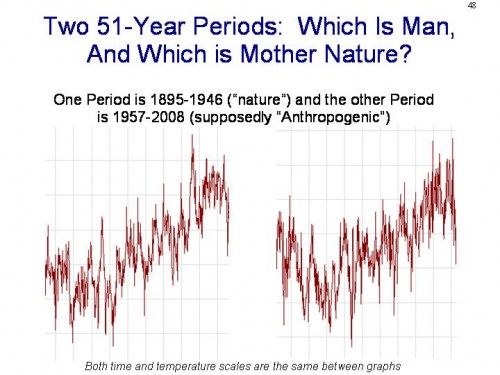
Hmm, the 90’s seem suddenly less unprecedented. In fact, from here, there seem to be a lot of bumps:
Period Length Trend
(Degrees C per decade)Significance 1860-1880 21 0.163 Yes 1910-1940 31 0.15 Yes 1975-1998 24 0.166 Yes 1975-2009 35 0.161 Yes
In fact, one can model past temperatures as a linear trend (that started well before CO2 was added in any substantial quantity) and periodic bumps
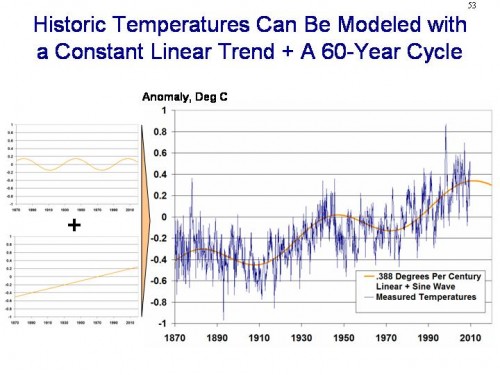
I wonder what periodic effect could be causing the bumps?
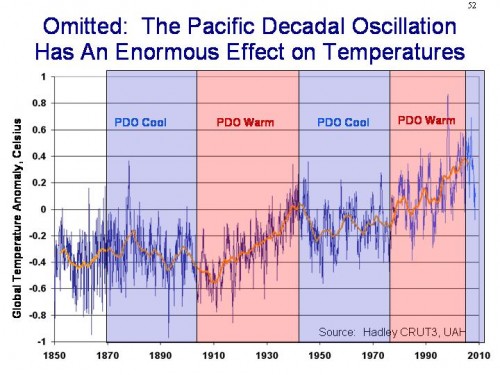
Even leaving out the AMO and other cycles and just simplifying to the PDO, it sees that ocean cycles might be important. Again, temperatures over the last 100+ years look a lot like a linear trend plus ocean cycle-driven bumps
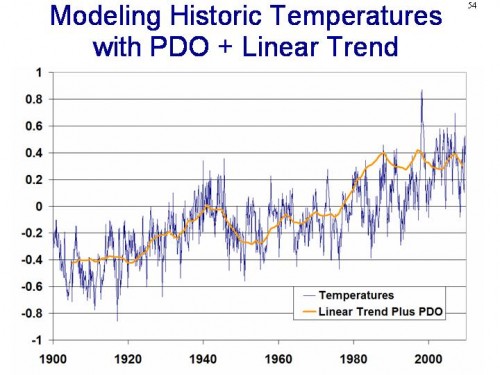
Knowlege Laundering
Charlie Martin is looking through some of James Hansen’s emails and found this:
[For] example, we extrapolate station measurements as much as 1200 km. This allows us to include results for the full Arctic. In 2005 this turned out to be important, as the Arctic had a large positive temperature anomaly. We thus found 2005 to be the warmest year in the record, while the British did not and initially NOAA also did not. …
So he is trumpeting this approach as an innovation? Does he really think he has a better answer because he has extrapolated station measurement by 1200km (746 miles)? This is roughly equivalent, in distance, to extrapolating the temperature in Fargo to Oklahoma City. This just represents for me the kind of false precision, the over-estimation of knowledge about a process, that so characterizes climate research. If we don’t have a thermometer near Oklahoma City then we don’t know the temperature in Oklahoma City and lets not fool ourselves that we do.
I had a call from a WaPo reporter today about modeling and modeling errors. We talked about a lot of things, but my main point was that whether in finance or in climate, computer models typically perform what I call knowledge laundering. These models, whether forecasting tools or global temperature models like Hansen’s, take poorly understood descriptors of a complex system in the front end and wash them through a computer model to create apparent certainty and precision. In the financial world, people who fool themselves with their models are called bankrupt (or bailed out, I guess). In the climate world, they are Oscar and Nobel Prize winners.
Update: To the 1200 km issue, this is somewhat related.
An Idea I Had Too Late
I was reading this post from Climate Quotes, wherein they demonstrate how the IPCC made a claim without proof, and when called on it, cast about for a source that turned out not to say any such thing. A lot of focus has been put on gray literature cited by the IPCC, but there appear to be at least as many occasions when the IPCC statement is not actually backed by the source cited.
The idea I had too late is that three years ago, when I had the time, I should have put the whole IPCC report on the web in some sort of Wiki or 2-column format (almost like a Medieval gloss) we could have linked and collected challenges to each individual statement and attribution. I think a couple of people are working towards this right now, but I kick myself for not thinking of it earlier. What a resource we would have now!
PS – No Consensus is looking for volunteers to identify and count the gray literature citations in the IPCC reports.
Just Your Typical Interview on Scientific Issues..
..typical, at least, if you are a skeptic. Tom Nelson beat me to the punch on an observation I was about to make about this interview with Marc Morano
[Check out this selection of questions from alarmist Randy Olson]:
RO: Okay, so let’s start with this — do you have doubts about President Obama’s birth certificate?
RO: Would you vote for Sarah Palin for president?
RO: Are you an anti-evolutionist?
RO: So who funds you?
RO: There are literally hundreds of celebrities on the global warming bandwagon. Are they all mis-informed? And why don’t you have any celebrities on the skeptics side?
RO: Last question. So you don’t feel that you’re anti-science?
Can you imagine an interview of, say, James Hansen that asked things like
- Do you have any doubts about the Bush National Guard memo’s publicized by Dan Rather?
- Would you vote for Ralph Nader for president?
- Are you an atheist?
- Who funds you?
- Are you willing to defend every statement Harrison Ford has made about global warming?
- Don’t you feel like you are anti-freedom?
The asymmetry of how skeptics are treated in the media is startling.
Digging into IPCC Working Group 3
Donna Laframboise and Richard Tol have some pretty devastating criticisms of the IPCC working group 3 report.
We Are Open and Honest With Everyone Who Agrees With Us
Phil Jones is now on the record saying that he doesn’t consider it normal scientific practice to share data and results with other scientists who wish to replicate his findings. And, it is pretty clear that Hughs tended to get a big fat pass from all his reviewers of published works, stating that no reviewer ever asked for his data, methodoloby, or computer code.
Warwick Hughes makes a pretty good case that in fact Jones was quite open with his data and working papers, as long as he thought the requestor was on his side. Once he found out certain people were working to replicated and find errors in his work, those people were locked out. The impressin one gets from his article is that there is now a pretty easy answer to “how can all these climate scientists be so wrong?” The answer is that they have never had any scrutiny whatsoever on their results, and anyone who attempted such scrutiny were marginalized and vilified by the inner core community.
When it comes to deciding whether to share data or not, standards have nothing to do with the decisions Jones made and he knows that. He knows he shared confidential data with Rutherford while he denied it to McIntyre and Hughes. He knows he regarded the confidentiality of those agreements quixotically. Violating them or hiding behind them on a whim. This was scientific malpractice. Lying about that now is beyond excuse.
Lindzen Presentation
This is a very enjoyable presentation by Richard Lindzen on climate and global warming. Folks who have watched my video won’t find much new, but Lindzen is the horse’s mouth, as it were. Via Maggies Farm
Requires RealPlayer, which scared me because for years RealPlayer was among the most annoying of spyware carriers, but the installation seemed OK. I like the format of video plus synchronized slides – I struggle with this in putting my presentations on the web.

